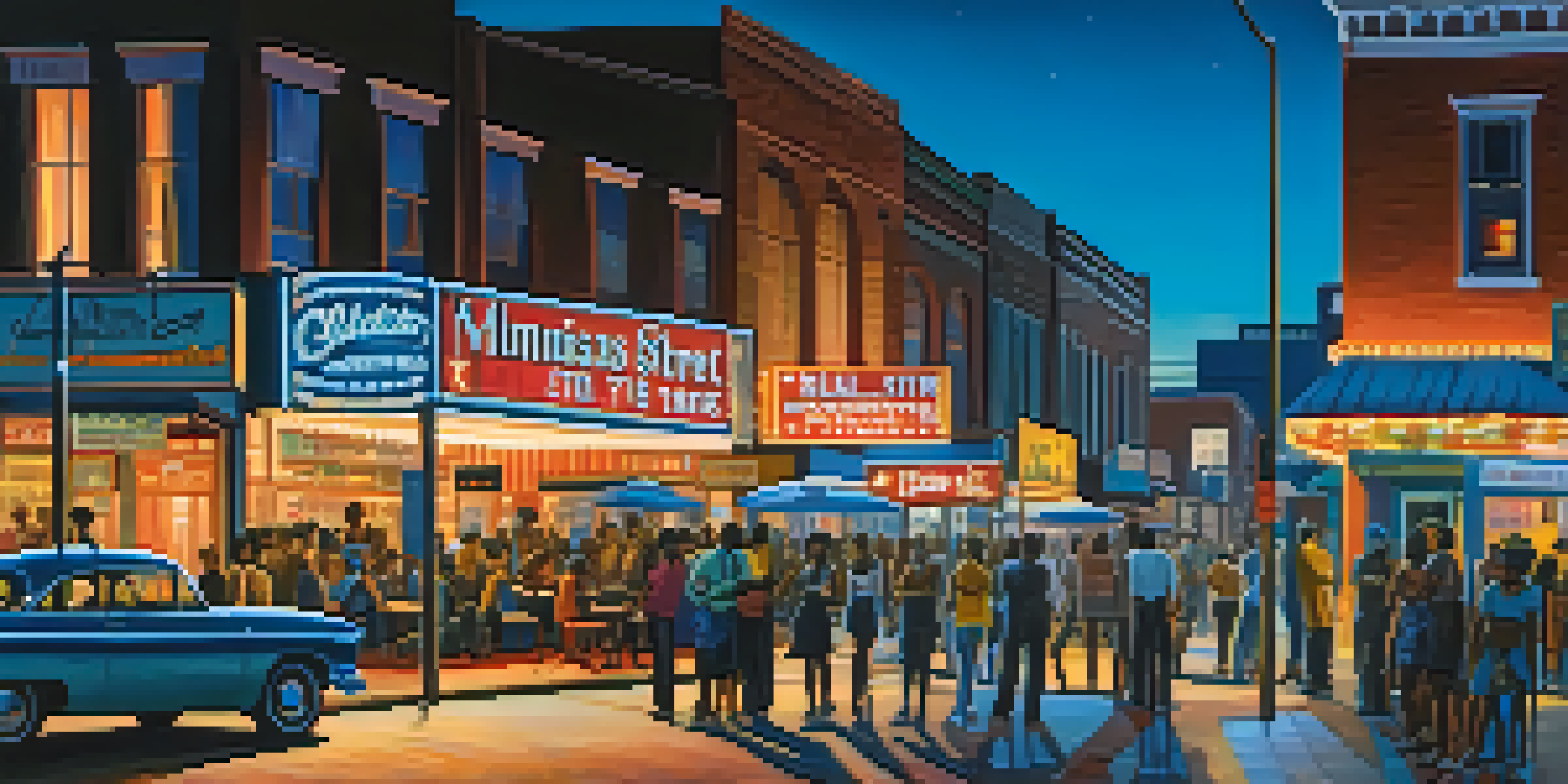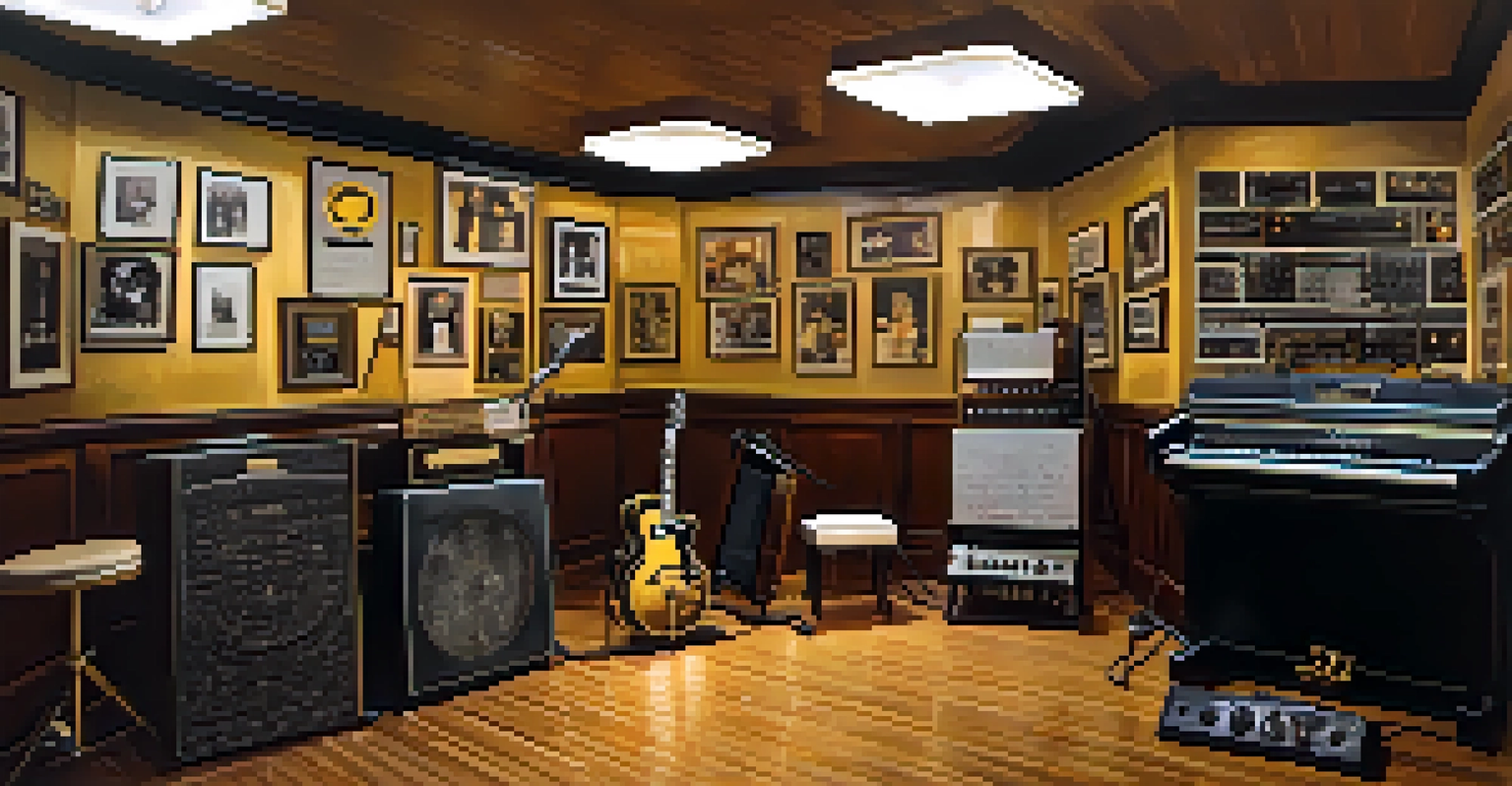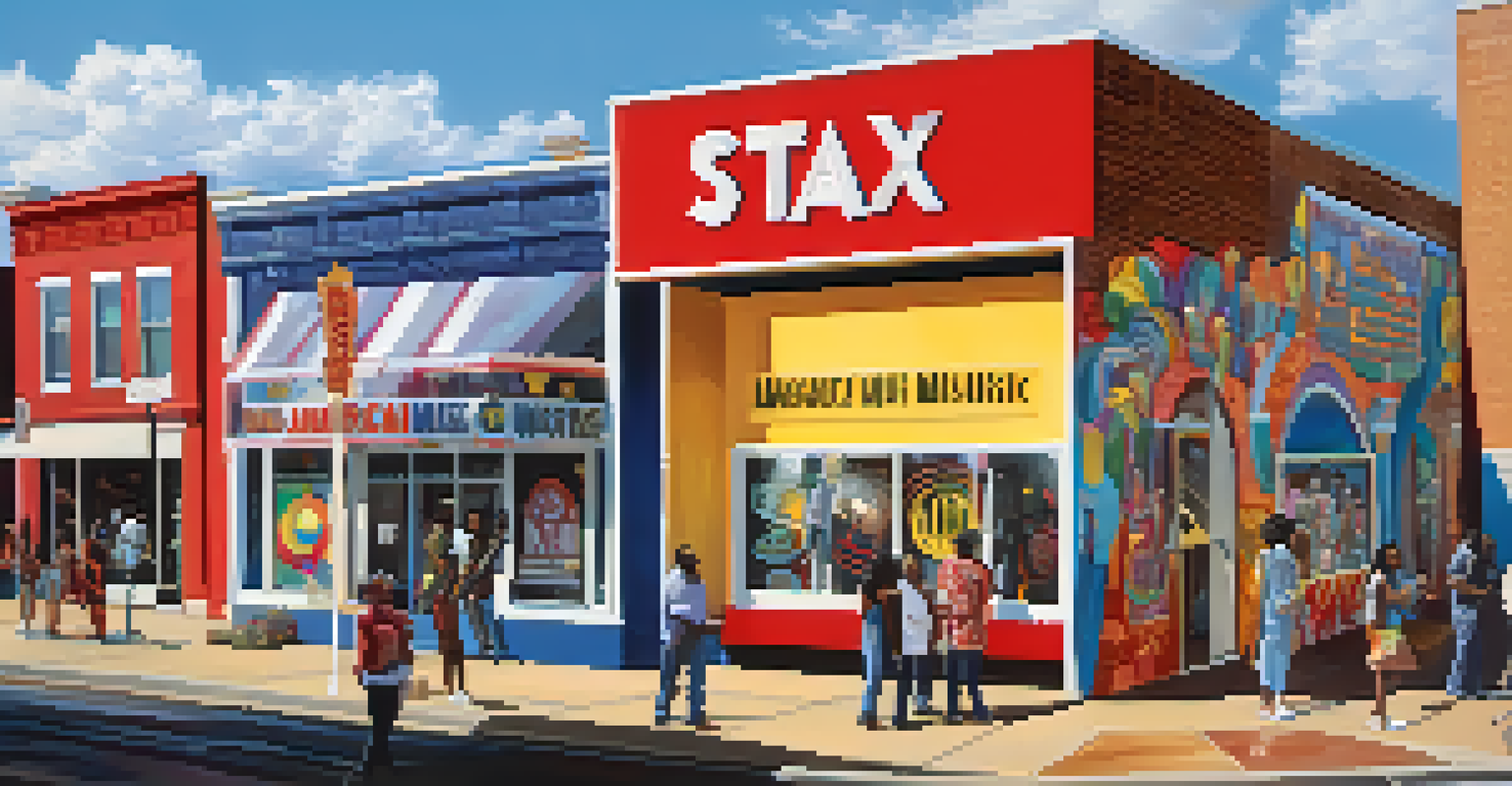Memphis Music Landmarks: A Journey Through History

The Birthplace of Blues: Beale Street
Beale Street is often referred to as the birthplace of the blues, and for good reason. This vibrant street has been a hub for musicians since the late 19th century, showcasing the sounds that would eventually shape rock and roll. Walking down Beale, you can almost hear the echoes of B.B. King and Muddy Waters, who played in venues that still pulse with music today.
Blues is a tonic for whatever ails you.
The street is lined with blues clubs and restaurants, each with its own unique story and sound. It’s a place where locals and tourists alike gather to enjoy live performances and immerse themselves in the rich culture of Memphis music. From the rhythmic strumming of guitars to soulful vocalists, Beale Street is a living museum of blues history.
Visiting Beale Street is not just about the music; it’s an experience steeped in the spirit of community and resilience. The street has survived challenges over the years, including economic downturns and social changes, yet it remains a symbol of artistic expression and cultural heritage.
Sun Studio: The Birthplace of Rock 'n' Roll
Sun Studio, often dubbed the 'Birthplace of Rock 'n' Roll,' is a must-visit for any music enthusiast. Opened in 1950 by Sam Phillips, this small recording studio became the launchpad for legendary artists like Elvis Presley, Johnny Cash, and Jerry Lee Lewis. Stepping inside, you can feel the electric energy that once inspired these icons.

The studio’s walls are lined with memorabilia from its rich history, including gold records and photographs of famous musicians. Guided tours provide fascinating insights into the recording processes and personal stories of the artists who recorded here. It’s like stepping back in time to witness the moments that shaped modern music.
Beale Street: Blues' Vibrant Heart
Beale Street is a cultural hub showcasing the rich history of blues music, where iconic artists like B.B. King and Muddy Waters once performed.
Sun Studio remains operational today, continuing to attract new talent while honoring its legendary past. Visitors can even book studio time to record their own tracks, making it a unique experience for aspiring musicians. The combination of history and innovation makes Sun Studio a true landmark in Memphis music.
Stax Museum: Celebrating Soul Music's Heartbeat
The Stax Museum of American Soul Music is a vibrant tribute to one of the most influential music genres. Located on the site of the original Stax Records, the museum showcases the rich legacy of soul music with exhibits featuring artists like Otis Redding and Isaac Hayes. It’s a place where the sounds of the past resonate loudly in the present.
Music is the soundtrack of your life.
Visitors can explore interactive displays, artifacts, and even a wall of honor dedicated to the legends of soul music. The museum not only preserves the history but also educates future generations about the cultural significance of soul. It’s a reminder of how music can reflect social issues and inspire change.
In addition to the exhibits, the Stax Museum hosts live performances and educational programs, fostering a deeper appreciation for soul music. This blend of history, culture, and education makes it an essential stop for anyone eager to understand the roots of American music.
Graceland: The Home of Elvis Presley
Graceland, the iconic home of Elvis Presley, is a pilgrimage site for fans of the King of Rock 'n' Roll. This sprawling estate offers a glimpse into the life of one of music's biggest legends. From the lush gardens to the famous Jungle Room, each corner of Graceland tells a story about Elvis’s life and career.
Visitors can tour the mansion and see personal items, awards, and even the room where Elvis recorded many of his hits. The experience is both intimate and awe-inspiring, as it allows fans to connect with the man behind the music. The grounds also feature exhibits dedicated to his music, films, and philanthropic efforts.
Sun Studio: Rock 'n' Roll's Launchpad
Sun Studio, known as the 'Birthplace of Rock 'n' Roll,' has been instrumental in shaping music history by launching the careers of legends like Elvis Presley.
Graceland isn’t just a museum; it’s a celebration of Elvis's life and lasting impact on music. Each year, thousands flock to Graceland to pay their respects, especially during the annual Elvis Week. The estate serves as a powerful reminder of Elvis’s enduring legacy in the world of music.
The Orpheum Theatre: A Historic Performance Venue
The Orpheum Theatre is a historic landmark that has entertained audiences for over a century. Originally opened in 1890, this beautifully restored venue has hosted a wide range of performances, from vaudeville acts to Broadway shows. Its ornate architecture and rich history make it a captivating place to experience live music and theater.
Attending a show at the Orpheum is more than just a night out; it’s a journey through time. The theatre's grand chandeliers and plush seating evoke a sense of nostalgia, transporting guests to an era of elegance. Whether it’s a concert or a musical, the acoustics and ambiance enhance every performance.
The Orpheum also plays a vital role in the local arts community, hosting events that showcase both local and national talent. It’s a place where culture thrives, and the love for performing arts is celebrated. For anyone visiting Memphis, catching a show at the Orpheum is a memorable experience.
The Levitt Shell: A Music Venue with Historical Roots
The Levitt Shell holds a special place in Memphis music history as the site of Elvis Presley’s first paid concert in 1954. This open-air venue has an intimate vibe, making it a favorite spot for live performances and community events. Today, it continues to honor its legacy by hosting free concerts throughout the summer.
The Shell is not just a stage; it’s a gathering place for the community to come together and celebrate music. With a diverse lineup of artists, from local bands to national acts, the Levitt Shell fosters a love for live music in a welcoming environment. Families often bring picnic blankets and enjoy evenings filled with music and camaraderie.
Music and Social Change Unite
The National Civil Rights Museum highlights the powerful connection between music and the civil rights movement, illustrating how artists used their voices to inspire change.
The venue's historical significance combined with its commitment to accessibility makes it a beloved landmark in Memphis. The Levitt Shell embodies the spirit of community and the power of music to unite people from all walks of life. It’s a place where memories are made under the stars.
Memphis Rock ‘n’ Soul Museum: A Cultural Treasure
The Memphis Rock ‘n’ Soul Museum is a captivating tribute to the musical genres that originated in this vibrant city. Housed in the historic Beale Street area, the museum explores the cultural and historical context that birthed rock and soul music. Through engaging exhibits, visitors can learn about the artists, influences, and struggles that shaped these genres.
The museum features a wealth of artifacts, including instruments, clothing, and personal stories from legendary musicians. It highlights the interconnectedness of various musical styles and how they contributed to the evolution of modern music. The immersive experience allows guests to appreciate the roots of rock and soul in a meaningful way.

By showcasing the stories of artists who overcame adversity to create timeless music, the museum serves as an inspiration for future generations. It’s a celebration of creativity, resilience, and the profound impact of music on society. The Memphis Rock ‘n’ Soul Museum is a must-visit for anyone wanting to understand the heart and soul of Memphis music.
The National Civil Rights Museum: Music and Social Change
The National Civil Rights Museum, located at the former Lorraine Motel where Dr. Martin Luther King Jr. was assassinated, is a powerful landmark that intertwines music and social change. The museum chronicles the history of the civil rights movement, highlighting the role music played in advocating for justice and equality. Artists like Sam Cooke and Nina Simone used their platforms to inspire change, making music an integral part of the movement.
Visitors can explore exhibits that showcase how music served as a voice for the struggles and aspirations of the African American community. Through powerful storytelling, the museum illustrates how songs resonated with the fight for civil rights, bringing people together in solidarity. It’s a poignant reminder of music's ability to inspire action.
The museum encourages reflection and dialogue about the ongoing journey for equality, reminding us that the fight is far from over. By connecting music with social justice, the National Civil Rights Museum enriches the understanding of both history and culture. It’s an important stop for anyone wanting to grasp the deep connections between music and social movements.